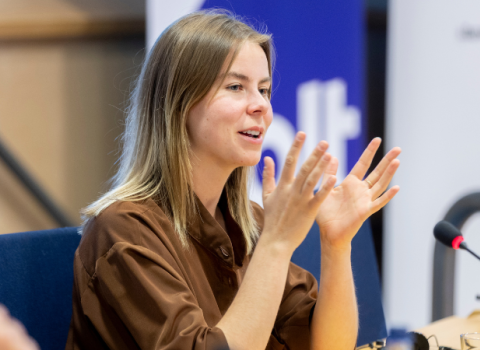Tia Loukkola, the European University Association’s new deputy secretary general, says policymakers should commit to enhancing the career paths of all academics, regardless of their roles

Tia Loukkola, the European University Association’s new deputy secretary general
Last month, EU ministers committed to improving research careers. But member states should go a step further and include teaching-focused academic careers as part of the push to create a single European market for research, says the EUA’s new deputy chief, Tia Loukolla.
University research and teaching go hand-in-hand. Yet, many academics prioritise the research pathway, given the limited incentives for choosing teaching. “We should see how we encourage our staff to work in these different areas of a university and show the value of all of them,” Loukkola told Science|Business.
In her new role, Loukkola aims to strengthen the EUA’s advocacy in higher education policy
The three missions of universities in education, research and innovation combine all sides of the knowledge triangle. That puts them at the core of the EU’s efforts to build stronger links within the European Research Area (ERA), the European Education Area (EEA), and a still-to-be-defined effort to boost innovation.
The Commission wants to complete the EEA by 2025, an “extremely ambitious” goal, according to Loukkola. It will build on previous efforts of the Bologna Process, which seeks to consolidate university standards and qualifications across Europe.
The single market for research, meanwhile, is starting anew after a failed attempt to link member states’ science ecosystems 20 years ago. Last September, the Commission put forward a proposal for a revamped ERA and the member states are now expected to sign a non-binding pact to finally bring the idea to reality.
Academic careers are caught in the crosshairs of these two initiatives, with different career pathways in different areas. “These two tracks come together in a university in one academic person when they need to make their career choices,” said Loukkola. This makes it important to discuss them as a package deal.
The EUA is advocating for ERA to include both research and teaching career pathways, but thus far the discussions on teaching careers have been concentrated in the realm of education.
There are ongoing talks about improving teachers’ competences as part of the EEA. Then, there is the European Universities Initiative, a pilot testbed for higher education collaboration. There are 41 EU-supported university alliances testing out different joint projects. One challenge singled out by these alliances is that niversities in different countries cannot jointly employ staff, which limits how far they can go in re-thinking university careers.
“That’s the structure in place at the moment. Whether they will be able to hire staff for the alliance and experiment with new ways, there’s still a question mark,” said Loukkola. In the end, education as well as employment regulations are in the hands of member states, which will have to take action if things are to change.
For now, rallying member states to work together and invest money on joint projects is all the Commission and universities can do. The efforts are producing results, according to Loukkola, pointing to increasing number of member states joining agreements to automatically recognise each other’s qualifications.
“The experience of the Bologna process, has shown us that we don’t achieve huge changes in a short time,” Loukkola said. “But there is a lot to build on, and what we have said is that to strengthen the collaboration and mobility of students and staff, we should build on those existing collaborations.”




 A unique international forum for public research organisations and companies to connect their external engagement with strategic interests around their R&D system.
A unique international forum for public research organisations and companies to connect their external engagement with strategic interests around their R&D system.